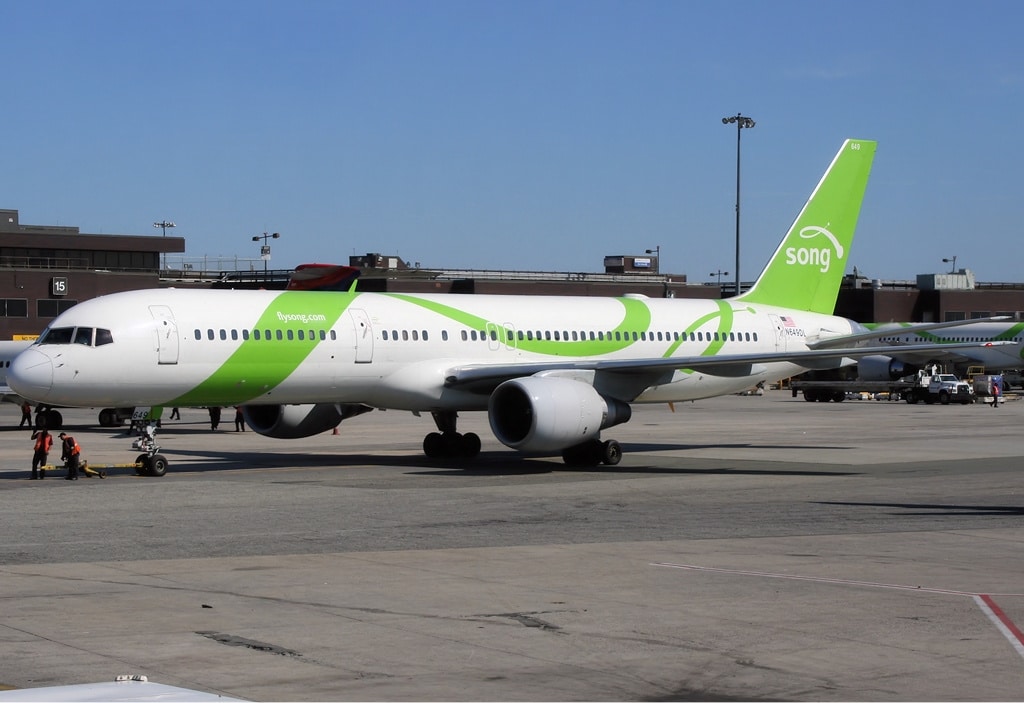Song

Delta wasn’t quite ready to throw in the towel as quickly as U.S. Airways. When it ceased operations of Delta Express, it had another, similar, low-cost airline concept waiting in the wings and Song commenced operations in 2003.
Just as Delta Express before it, Song focused on leisure travel between the Northeast and Florida, now competing primarily with only JetBlue. However, Song did expand its reach a bit further than Delta Express had, with a few flights to the West Coast and the Caribbean.
Now, instead of offering travelers no service at all throughout their budget flight experience, Delta upped the ante and gave travelers more luxury for their low airfare, touting luxury amenities such as roomier leather seats, free drinks and seatback entertainment. At its height, Song offered more than 200 daily flights.
Song put a huge emphasis on branding, targeting female solo travelers and positioning itself as a fashionable brand. Healthy, organic and brand-name food items were offered on flights. The crew uniforms were designed by Kate Spade and Delta tapped New York tastemakers of the day to further influence the in-flight experience.
However, all this forward-thinking fashion focus was not enough to keep Song afloat and by 2006, Song was folded back into Delta as part of the parent company’s bankruprcy. Delta then transitioned the near-50 Song Boeing 757-200 aircraft to the mainline fleet. The carrier proved to be a valuable testbed for Delta’s amenities. Personal in-seat entertainment and buy on board food, first made common on Song flights, were later introduced into much of the fleet later in the decade.
United Shuttle and Ted

United tried twice with an airline within the airline. It first tried Shuttle by United to compete with Southwest on the West Coast. The effort failed due to operational issues and a downturn in the economy in 2001.
It again tried with a more trendy attempt named Ted a few years later. Ted was another airline that, like Song, attempted to make low-cost and budget-friendly fashionable.
The airline started service just a year after Song, launching in 2004 in Denver, where it was competing with Frontier Airlines. Ted boasted a fleet of 56 Airbus A320 aircraft.
While it technically only offered one class of service, Ted offered two sub-classes of service — Economy Plus and regular economy. Economy Plus seats gave passengers five extra inches of leg room. Every seat offered audio entertainment, but video entertainment was provided via 20 overhead screens that played throughout the cabin.
Ted traveled to nearly two dozen destinations, both domestic and international, with a few flights to the Caribbean.
Just like Song, Ted placed a huge emphasis on branding. United tried to make the Ted brand seem personal and friendly. They personified the brand with catchy marketing phrases like “Meet Ted.” United also put the Ted name on everything they could. Their video screens throughout the aircraft were called Tedevision. The in-flight audio entertainment was referred to as TedTunes.
Ted lasted a few years longer than Song, but Ted also succumbed to fuel costs, shuttering in 2009. Aircraft were added back into United’s regular fleet.
Bottom line? Airlines within an airline is a tough business. If you are an airline exec, study the part. We wouldn’t recommend trying it.
